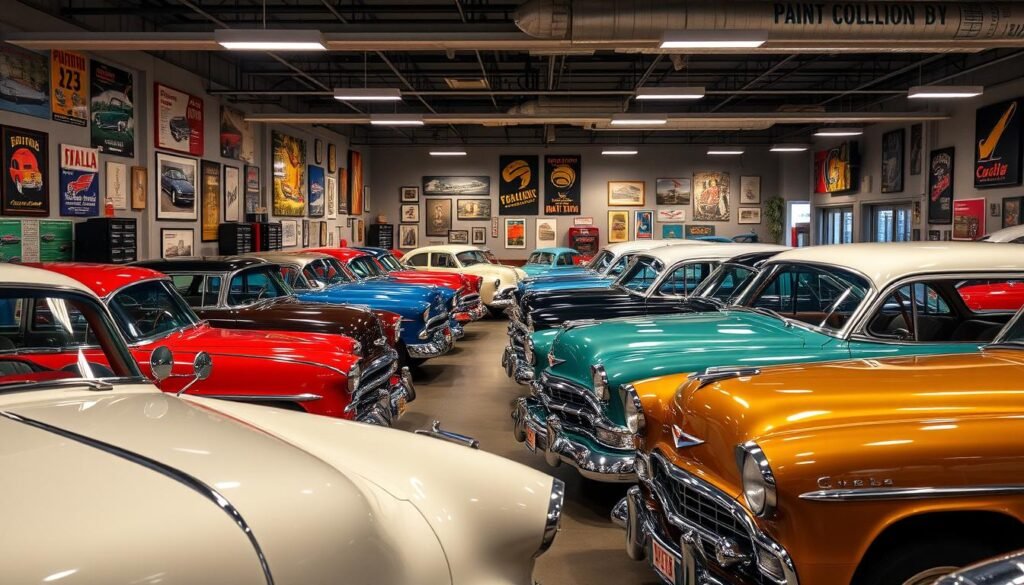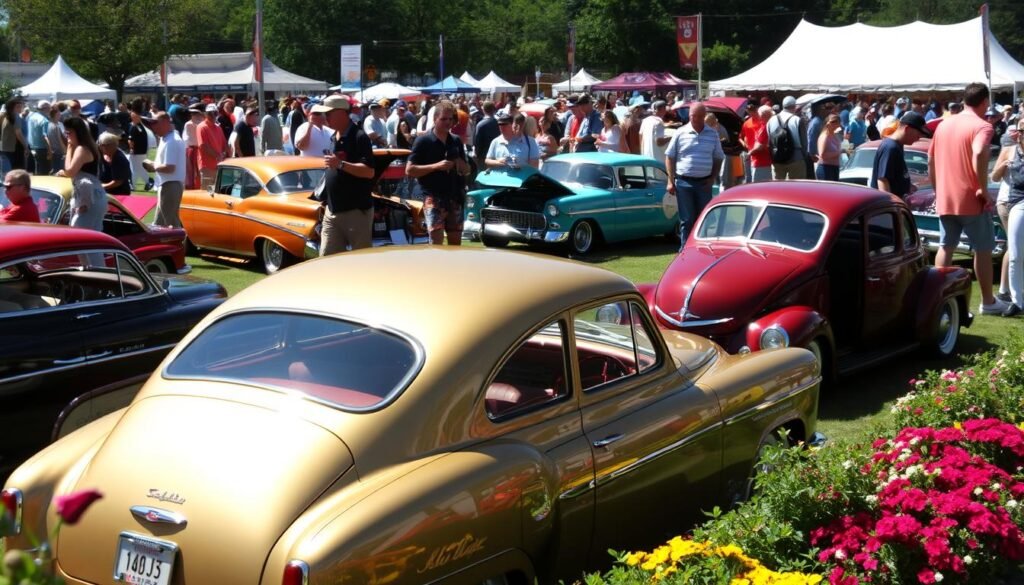Entering the world of car collecting is like starting a journey through car history. It’s a place where passion, nostalgia, and love for old craftsmanship meet. Each vintage car tells a story of creativity and skill from the past.
The world of classic cars is full of variety, from Art Deco to muscle cars. It’s a mix of old and new. Whether you’re new or experienced, finding a rare car or restoring an old one is exciting. This hobby has turned into a smart investment, as classic car values keep going up.

Key Takeaways
- The allure of car collecting and classic cars lies in their emotional and historical significance.
- Vintage automobiles are not just vehicles, but works of art that capture the design evolution of the automotive industry.
- Car collecting has grown beyond a hobby, becoming a viable investment opportunity as the value of classic cars continues to rise.
- Exploring the world of car collecting offers a unique journey through automotive history and the opportunity to own a piece of that legacy.
- The passion for classic cars transcends boundaries, uniting enthusiasts from all walks of life in a shared appreciation for these timeless machines.
The Evolution of Classic Car Collecting Through the Ages
Car collecting has a rich history that spans decades. It shows how automotive history, collector vehicles, and rare car models have evolved. What started as a niche hobby has grown into a thriving industry.
The Golden Era of Automotive Design
The 1930s to the 1960s were the golden years for car design. During this time, car makers created some of the most iconic collector vehicles in the world. They focused on style, engineering, and performance, making cars that are still loved today.
From Hobby to Investment: The Transformation
Car collecting has changed from a hobby to a profitable investment. The demand for rare and well-kept automotive history has grown. This has made the market for collector vehicles boom, with some models increasing in value dramatically.
Key Milestones in Car Collecting History
- The Antique Automobile Club of America (AACA) was founded in the 1930s. It helped make car collecting a recognized hobby.
- The National Automobile Museum Association (NAMA) was formed in the 1940s. It focused on preserving and showing historic cars.
- Prestigious car shows and auctions like Pebble Beach Concours d’Elegance started in the 1950s and 1960s.
- The Hagerty Price Guide was introduced in the 1980s. It helped value collector vehicles accurately.
- Online platforms and social media have changed how people share their love for rare car models since the 2000s.
The history of classic car collecting is fascinating. It shows the lasting appeal of these automotive history icons. From the golden age of design to today’s investment opportunities, car collecting continues to excite people all over the world.
Car Collecting and Classic Cars: Understanding the Basics
As car enthusiasts, we find the world of vintage automobiles and antique cars fascinating. Collecting these cars is more than a hobby; it’s a journey through history. Each car has its own story to tell. We’ll look at the basics of car collecting and what makes a car collectible.
What makes a car a “classic”? It’s usually a car over 25 years old. Some say it should be 20 years old. These cars are loved for their rarity, history, and condition. There are many types of classic cars, like muscle cars and sports cars.
- Rarity: The fewer a model is made, the more valuable it is to collectors.
- Historical Significance: Cars that were important in history or linked to famous people are highly wanted.
- Condition: The better a car is kept or restored, the more it’s valued.
Knowing these key points is important for those starting to collect vintage automobiles. Whether you like sports cars or muscle cars, there’s a lot to explore. Car collecting lets you dive deep into your love for cars.
“Collecting classic cars is not just about the vehicles themselves – it’s about preserving the rich history and craftsmanship that went into their creation.”
As you get into antique cars and vintage automobiles, learn the industry’s terms and ideas. Knowing about chassis numbers and provenance is key. These details help you in the collector’s market and when buying cars.
Collecting cars is not just about the cars. It’s about the stories they tell and the community you join. Enjoy the passion, history, and excitement of finding your next car treasure.
Essential Tips for Starting Your Classic Car Collection
Starting your classic car collection is an exciting journey. It’s key to have a solid plan. Whether you’re new or experienced, these tips will guide you in building your dream collection.
Researching Your First Purchase
Before buying your first classic car, do your homework. Learn about market trends and the unique qualities of different models. Use online resources, talk to experts, and visit car shows to get insights.
Building a Network in the Classic Car Community
Connecting with others who love classic cars is crucial. Join car clubs, go to events, and join online forums. This network can help you find rare parts, get restoration tips, and stay updated on the car collecting and classic cars market.
Understanding Market Values and Trends
Keeping up with the collector vehicles market is key. Look at auction results, read industry news, and talk to appraisers. This will help you find good deals and avoid overpaying for your car collecting and classic cars finds.
By following these tips, you’re on your way to a fantastic classic car collection. It will show your passion and could even grow in value. Happy collecting!
Vintage Automobile Authentication and Documentation
We love collecting antique cars and rare models. Knowing a car’s true history is key. It shows the car’s value and importance.
Checking a car’s VIN is a big step. It tells us where the car came from and when. Documents like manufacturer records and sales invoices help prove a car’s past.
Getting help from experts is smart. They check the car’s parts and work. This helps tell if a car is real or not.
“The thrill of owning a piece of automotive history lies in the journey of uncovering its authentic past.”
By focusing on authenticity, we keep the history of these cars alive. This makes our collections valuable and respected. With the right checks and papers, we can show off our love for these classics.

| Verification Method | Key Benefits |
|---|---|
| VIN Check | Identifies the car’s origin, production year, and original specifications |
| Historical Documentation | Corroborates the car’s lineage and legitimacy through manufacturer records, sales invoices, and owner registrations |
| Professional Appraisal | Provides a comprehensive assessment of the car’s originality and condition through expert examination |
Classic Car Restoration: A Labor of Love
Restoring a classic car is a journey filled with passion, determination, and detail. You can do it yourself or hire professionals. Either way, you need to know a lot about classic car maintenance. This ensures the car stays true to its original form.
Professional vs. DIY Restoration
Doing it yourself can be rewarding if you have the time and skills. It lets you learn about your car and bond with the restoration. But, professionals have the skills and tools for a perfect finish.
Sourcing Original Parts
- Finding original parts is hard but crucial for keeping the car’s history intact.
- Joining clubs and searching online can help find rare parts.
- Quality reproduction parts are sometimes needed, but they must match the originals.
Preservation Techniques and Best Practices
Keeping your classic car in top shape is ongoing. It involves protecting the paint and preventing rust. Knowing how to store and maintain your car is key.
| Restoration Approach | Advantages | Challenges |
|---|---|---|
| Professional Restoration | Concours-level finish Expertise in specialized techniques Access to specialized tools and facilities | Higher cost Longer turnaround time Limited personal involvement |
| DIY Restoration | Personalized experience Opportunity to learn and develop skills Lower overall cost | Steep learning curve Requirement of specialized tools and space Potential for mistakes and longer completion time |
“Restoring a classic car is not just about bringing it back to life, but also about preserving a piece of automotive history. It’s a labor of love that requires dedication, patience, and a deep appreciation for these timeless machines.”
Navigating Classic Car Shows and Prestigious Auctions
As car enthusiasts and collector vehicle lovers, we love going to classic car shows and auctions. These events let us dive into the world of rare and unique cars. Whether you’re a seasoned collector or just starting, these events are both exciting and challenging.
From local meets to international auctions, the classic car world is full of chances to meet others and find rare cars. With the right knowledge, we can enjoy these experiences more and improve our car shows and auctions journey.
Preparing for the Event
Before going to a classic car show or auction, do your homework. Know the event’s details, location, and any needed registration. Talking to other car enthusiasts and joining online groups can also help a lot.
Navigating the Event
At the event, take time to see all the collector vehicles on display. Talk to the owners, ask questions, and learn about the cars’ history. Remember the auction rules and watch the bidding closely to spot good deals.
| Top Classic Car Events | Location | Highlights |
|---|---|---|
| Pebble Beach Concours d’Elegance | Pebble Beach, California, USA | Prestigious annual event showcasing the finest vintage and classic cars |
| Goodwood Festival of Speed | Goodwood, West Sussex, UK | Celebration of motorsport history, featuring iconic race cars and renowned drivers |
| Amelia Island Concours d’Elegance | Amelia Island, Florida, USA | Renowned for its exceptional collection of rare and unique automobiles |
By diving into the world of classic car shows and auctions, we not only feed our love for car history. We also get to connect with a lively community of fellow car lovers. With good preparation and an open mind, these events can be truly memorable.

Maintaining and Storing Your Classic Car Collection
Keeping your classic car collection in top shape is a big job. It involves using climate-controlled storage and a detailed maintenance plan. This approach helps keep your collector vehicles looking great.
Climate Control and Storage Solutions
Storing your classic cars right is key to protecting your investment. A climate-controlled facility is the best choice. It keeps the temperature, humidity, and air quality just right to prevent damage.
Also, having secure access and cameras gives you peace of mind. Your classic cars are safe and sound.
Regular Maintenance Schedule
- Regular checks and services are vital for your classic cars.
- Stick to a detailed maintenance plan. This includes oil changes and tune-ups.
- Use experts who know collector vehicles. They’ll give your classics the right care.
Insurance and Security Considerations
Protecting your classic car collection needs a few steps. First, get insurance made for collector vehicles. These cars are often worth more and need special coverage.
Also, invest in top-notch security. This includes cameras, sensors, and strong storage. It keeps your cars safe.
Follow these tips to keep your classic car collection in top shape. This way, your love for classic car maintenance and collector vehicles will last for years.
Investment Potential: Classic Cars as Assets
For car collecting enthusiasts, the thrill of the hunt and the joy of restoration are key. But many have found that classic cars can also be valuable investments. They offer the chance for significant growth in value over time. We’ll look at what drives this market and how to balance passion with financial thinking.
The rarity and exclusivity of classic cars make them appealing investments. As time goes on, fewer of these sought-after models remain. This scarcity, combined with growing demand, can lead to big increases in value for certain models.
The emotional and sentimental value of classic cars also boosts their worth. Collectors often pay more for a car that holds a special place in their heart. This emotional connection plays a big role in the classic car market.
| Vintage Car Model | Average Annual Appreciation (2010-2020) |
|---|---|
| 1967 Ford Mustang | 8.2% |
| 1961 Aston Martin DB4 | 11.5% |
| 1955 Mercedes-Benz 300 SL | 13.7% |
Understanding market trends and value factors is key for any investment. Condition, rarity, and historical significance are crucial. Research, networking, and staying informed can help collectors make smart choices.
While the investment potential of classic cars is tempting, balance is essential. Passion for the hobby should not be lost in financial considerations. The true joy of classic car collecting is preserving automotive history, with the chance for financial gain.

Top Classic Car Models That Define Collecting Excellence
For those who love vintage cars, the world of classic car collecting is amazing. It’s filled with iconic and sought-after models. These cars are not just vehicles; they are symbols of design and history.
Let’s look at some of the top classic car models that have made car collecting an art:
- 1962 Shelby Cobra – This American sports car is famous for its sleek design and strong V8 engine. With only a few thousand made, the Shelby Cobra is a top choice for collectors.
- 1955 Mercedes-Benz 300 SL Gullwing – The 300 SL Gullwing is known for its stunning design and innovation. Its unique doors and advanced engineering make it highly valuable at auctions.
- 1967 Chevrolet Corvette Stingray – The Stingray is an iconic American sports car from the 1960s. Its sleek body and powerful engine make it a favorite among collectors.
| Model | Year | Estimated Value (USD) |
|---|---|---|
| 1962 Shelby Cobra | 1962 | $1 million – $15 million |
| 1955 Mercedes-Benz 300 SL Gullwing | 1955 | $4 million – $30 million |
| 1967 Chevrolet Corvette Stingray | 1967 | $50,000 – $150,000 |
These are just a few examples of the iconic classic car models that have captured the hearts of collectors and enthusiasts. As the vintage car market grows, we’ll see more rare models emerge. They will be true pieces of automotive history and collecting excellence.
Conclusion
The world of car collecting and classic cars is truly captivating. It spans from the enchanting era of automotive design to becoming a savvy investment. We’ve explored the rich history and changing world of classic car enthusiasts.
These vintage cars have a special charm. They bring back memories, celebrate craftsmanship, and connect us to a community of car lovers. Whether you’re a seasoned collector or just starting, the joy of finding, fixing, and showing off these cars is unmatched.
The future of car collecting is exciting, with new tech, changing trends, and young collectors joining the scene. But the core values stay the same. A love for design, respect for car history, and a wish to keep these icons alive. We’re sure classic cars will keep inspiring and captivating car fans for years to come.
FAQ
What defines a classic car?
A classic car is usually a vehicle over 20 years old. It has unique design and historical importance. Different groups have their own rules, but most agree classic cars show the past’s engineering and craftsmanship.
How do I start building a classic car collection?
To start, research the market and talk to other collectors. Find the models or eras you like most. Knowing what makes a car collectible is key. Start small, choose cars you love, and be patient as you grow your collection.
What are the best ways to maintain and store my classic cars?
Keeping your classic cars in good shape is vital. Use climate-controlled storage and a regular maintenance plan. Protect the paint and prevent rust. Also, get special insurance to protect your collection.
How can I authenticate the provenance of a classic car?
Checking a car’s authenticity is crucial. Do thorough research, like VIN checks and historical document reviews. Talk to expert appraisers too. This ensures the car’s true value and identity.
What are some of the most prestigious classic car events and auctions?
Top events include the Pebble Beach Concours d’Elegance and the Amelia Island Concours d’Elegance. Barrett-Jackson Auction and Monterey Car Week are also famous. These events showcase rare cars and offer a chance to buy at auctions.
How can I invest in classic cars as an asset?
Classic cars can be a good investment. Research trends and find undervalued models. Diversify your collection. Get advice from collectors and financial experts to make smart choices.

